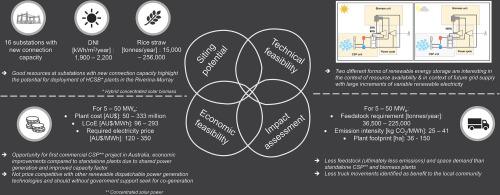Energy Conversion and Management ( IF 10.4 ) Pub Date : 2021-05-14 , DOI: 10.1016/j.enconman.2021.114244 Ella Middelhoff , Leandro Andrade Furtado , Juergen H. Peterseim , Ben Madden , Fabiano Ximenes , Nick Florin

|
Cost-efficient dispatchable renewable technologies are critical for enabling the energy transition towards 100% renewable generation. One promising example involves the integration of biomass boilers with concentrated solar power (CSP) referred to as hybrid concentrated solar biomass (HCSB) plants.
This study evaluates the technical feasibility of a potential plant design for a rice-straw-fed HCSB plant. A case study for the Riverina-Murray region of Australia, a prime area for deployment owing to abundant solar and biomass resources is presented.
Based on an assessment of different hybrid concepts, we investigate a solar-biomass hybridization with a concentrated solar tower system. With this hybrid concept, both the CSP and biomass boiler can raise steam to feed the high-pressure turbine enabling greater thermal efficiency. We evaluate HCSB plant performance at four scales: 5, 15, 30 and 50 MWe. Depending on size, HCSB plants reach thermal efficiencies from 21 to 34%. Considering the economic feasibility, assuming an internal rate of return (IRR) of 11%, viable deployment requires an electricity price of AU$ 120–350/MWh.
The techno-economic assessment demonstrates advantages compared to standalone CSP plants and highlights the competitiveness of HCSB plants compared to other renewable technologies in Australia. The social and environmental impact assessment highlights additional benefits including local job creation and potential carbon emission mitigation.
中文翻译:

澳大利亚用于发电的混合浓缩太阳能生物质(HCSB)厂:技术经济和环境绩效的设计和评估
具有成本效益的可调度可再生技术对于使能源向100%可再生发电的过渡至关重要。一个有前途的例子涉及将生物质锅炉与集中式太阳能发电(CSP)集成,称为混合式集中式太阳能生物质(HCSB)电厂。
这项研究评估了稻草喂养的HCSB植物的潜在植物设计的技术可行性。本文以澳大利亚的Riverina-Murray地区为例,该地区由于太阳能和生物质资源丰富而成为部署的主要地区。
基于对不同混合动力概念的评估,我们研究了利用集中式太阳能塔系统进行的太阳生物量杂交。利用这种混合动力概念,CSP和生物质锅炉均可提高蒸汽供给高压涡轮,从而提高热效率。我们以四种规模评估HCSB电厂的性能:5、15、30和50 MW e。根据规模,HCSB工厂的热效率可达21%至34%。考虑到经济可行性,假设内部收益率(IRR)为11%,可行的部署需要电价为120-350澳元/兆瓦时。
技术经济评估显示了与独立CSP电厂相比的优势,并突出了HCSB电厂与澳大利亚其他可再生技术相比的竞争力。社会和环境影响评估强调了其他好处,包括创造本地就业机会和潜在的碳排放缓解。



























 京公网安备 11010802027423号
京公网安备 11010802027423号